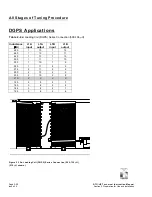
ATU-HP Technical Instruction Manual
Page 2-5
Section 2 Preparation for Use and Installation
Issue 2.0
2.2.5 Customer Required
Interfacing
The following paragraphs describe the
connections that must be made to the ATU
by the customer. For ease of installation, it
is recommended that wiring and applicable
connectors are on site prior to unpacking/
installing the ATU. Figure 2-3 illustrates the
ATU-HP’s interface.
2.2.5.1 RF Output Feed Cable
The method by which the ATU output (J2)
connects to the antenna is critical because
of the high voltage, current and impedance
levels at this interface. The antenna feed
RF cable connects to the feed-through/
insulator located at the top left of the ATU
cabinet. This cable must be of adequate
diameter to avoid corona discharge, must
not contain sharp bends and should have
sufficient length to permit a drip loop at the
feed-through/insulator. Refer to Figure 2-2
(a) or (b) for a typical downlead connection.
2.2.5.2 Remote Control/Monitor Wiring
The ATU-HP can interface with a Nautel
Vector series DGPS or NDB transmitter
using RS-485 serial communication.
Connections are made via a cable that
passes through a liquid-tight connector in
the side of the cabinet, to the ATU control/
monitor PWB (9-pin D connector J3 or
terminals TB3-6 though TB3-10). The cable
should be shielded and suitable for direct
earth burial, to be installed underground
between the transmitter and ATU-HP. The
RS-485 specification limits the cable length
to a maximum of 4000 ft. (1220 m).
The following pin-out and terminal
assignment applies:
+5V
A1J3-1
or
A1TB3-6
Ground
A1J3-2 or A1TB3-7
TX/RX
A1J3-3
or
A1TB3-8
TX/RX
A1J3-4
or
A1TB3-9
DE/RE
A1J3-5
or
A1TB3-10
2.2.5.3 RF Input Cable
A suitably rated, good quality, 50
Ω
RF
coaxial cable should be used to
interconnect the ATU-HP and the
transmitter. The RF input connection is
made to N connector J3 at the side of the
ATU-HP cabinet. Where practical, it is
recommended that the cabling between the
transmitter and ATU-HP be installed
underground (i.e., suitable for direct earth
burial). The only penalty for long distances
between the ATU-HP and the transmitter is
the cost of the cable and the power loss in
the coaxial feeder cable. This loss is
typically 0.1 dB/100 m for a good quality,
1/2-inch diameter cable.
2.2.5.4 AC Power Cable
The ac power connection is made via a
cable that passes through one of the liquid-
tight connectors on the side of the ATU-HP
cabinet to TB2 of ATU control/monitor
PWB A1 (see ac power options in Figure
2-3). The ac power cable should conform
to local electrical codes. The ac power for
the ATU-HP should be provided on a
dedicated circuit from the service
entrance. Facilities to disconnect this
service should be provided. Ac power
requirements for obstruction lighting, etc.,
should be individually supplied by branch
circuits from the service entrance panel.
NOTE
The ATU-HP is configured to operate from
one of three ac power sources:
115 V ac, single-phase, 0.25 A max.
230 V ac, single-phase, 0.15 A max.
230 V ac, split-phase, 0.15 A max.
2.2.5.5 Ground Connection
A ground cable (6 AWG minimum) must be
connected between the centre of the
antenna ground plane and the ground lug
located on the bottom, left-hand side of the
ATU-HP cabinet. This ground cable should
be continuous and low resistance to ensure
efficient operation.
















































